Maintenance Tips, Policies, and FAQ's
As a pioneer cemetery that relies on
volunteers and family members for much
of the maintenance, it's important to know how best to protect these
artifacts.
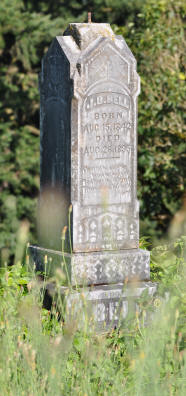 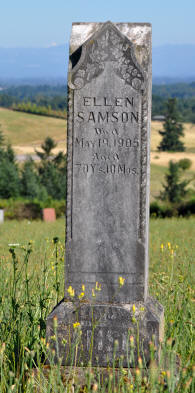
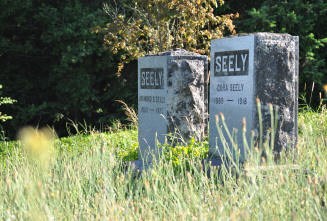
Why don't they mow the grass more
often?
Pleasant View Cemetery is a pioneer or historic cemetery
from the time of the rural cemetery movement. It
is not a
lawn cemetery. That means that many of the
monuments were installed prior to the age of mechanized
lawn mowing. You may notice that most of the old
marble columns are perched on tall sandstone bases, with
their inscriptions near the top. The expectation
was that much of the time tall grass would be growing
around the lower part of the monument. Because
those old sandstone bases are so vulnerable to blades
and string trimmers, we try to keep lawn mowing to an
"as needed" basis, mostly around major holidays or
scheduled services. |
What if we want to trim around our
family's monuments?
You are encouraged to carefully trim around
your monuments, but be extra careful to keep any
mechanized equipment away from the monuments. Hand
trimming is usually sufficient for working around a few
monuments. We discourage use of chemical
pesticides or herbicides in the cemetery except for
special circumstances (poison oak, for instance). |
Are there rules about decorations?
Unlike lawn cemeteries, pioneer cemeteries
are usually more relaxed about a variety of decorations.
Grave decorating customs vary by culture, family, and
individual so we try to be respectful of a family's
needs and wishes. We do ask that you remember that mowers will come
by now and then. That means light-weight items may
get blown away, and glass items are vulnerable to being
struck by flying debris. Please don't leave mylar
or other balloons unless you plan to come back and get
them in a few days. They will eventually come
loose and travel into the neighbors' property. Things like plant
containers, seasonal decorations, flags, or artificial
flowers are fine but understand that they will be
removed if they deteriorate or are
clearly past their prime or season. |
Are we allowed to plant things?
You can plant flowers or bulbs near your
monument, but please keep them out of the path of the
mowers. Remember that there is no water at the
cemetery so that will limit what and when you plant.
If you would like to plant something more permanent like
a shrub or tree, please talk to Julie or Charlotte first
to be sure the location will work and that there is a
plan for watering the first summer. Finally, don't
plant anything that might spread or become invasive. You
may have noticed the vinca (green vine with pretty blue
flowers, growing in many areas of the cemetery) which
will eventually cover everything without our vigilant
control efforts. |
Monument Cleaning and Care
Many families make care of their monuments a regular
part of family life.
Even once every few years can make a big difference.
Here are a few pointers to keep in mind.
|
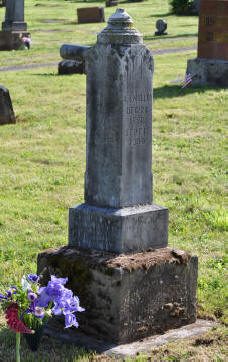 |
Almost all of our monuments are made from either marble
or granite, with sandstone, granite, or
concrete bases and foundations. Most
monuments prior to 1910 are marble. Around
that time cutting technology improved and
granite became the monument of choice
because it is much harder and more durable.
Here's how to recognize
them: |
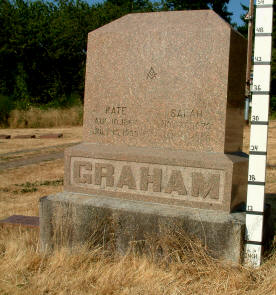 |
|
←
Marble |
Granite
→
|
|
Marble usually starts out
white or light gray, but over time turns
darker or nearly
black due to lichen growth. You can usually still see the
"marbling" that gives it the name. Marble
columns are usually on a sandstone base.
The sandstone is especially fragile. Marble
and sandstone are very porous and wear
easily. |
|
Granite is usually
speckled, comes in many colors, and can be
polished to a high gloss. This one is
a rose-colored high gloss monument and
plinth sitting on a gray, rough-finished
granite base.
Sometimes the base is concrete. Granite is
much harder than marble, but metal
implements will still scratch or chip it. |
What to Bring
- A garden knife or other non-motorized edging tool
to cut the sod back from around the monument
- A broom or whisk broom to sweep off monuments
- Small scrub brush or toothbrush to clean out
engravings
- Sharpened wooden (not metal) sticks to clean out
engravings
- Water and rags to wipe and polish granite
- If your monument has inverted flower containers
you may need a screwdriver or similar implement to
help pry them up if they are stuck
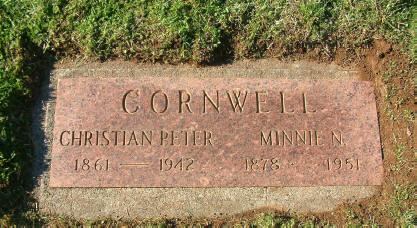 |
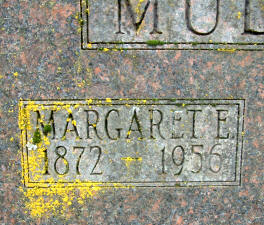 |
|
Granite monument with
concrete apron nearly covered by sod |
Engraving in need of
cleaning |
·
Monument
Cleaning
Keeping the sod from swallowing everything is one of
the biggest challenges in the Northwest, so bring
something to cut any sod back from the concrete aprons
that surround most granite monuments. Use small brushes
or toothbrushes to clean moss and debris out of
engravings. Sharpened wood dowels or other wooden
sticks also work
well, but never use metal or wire implements that can
scratch the stone. Since there is no water at the
cemetery, having a spray bottle of plain water and some
rags often comes in handy. Using soaps or chemicals is
NOT recommended because older stones, especially the
marble ones, can be very porous and will suck impurities
or chemicals
in like a sponge, causing damage later. Planning a
cleaning party? Let me know and I will pop up and
do a brief training demo if I am available.
Charlotte
·
Use
Extra Caution with Older Stones
Most monuments before 1910 were made of marble,
which is much softer and more fragile than granite.
Since any cleaning (even falling raindrops) removes some
material, these stones should only be cleaned once every
few years. All the marble at Pleasant View was
cleaned in 2014 so it should not need major attention
for several years. Work should only be done in
cool, preferably damp weather. Use plenty of plain water, scrub gently
working from the bottom up, and
rinse thoroughly. The bases of
these monuments are usually made of sandstone, which is
even more fragile than the marble. Scrubbing sandstone
is never a good idea and motorized equipment like string
trimmers often does permanent damage. Just remove grass
and weeds by hand if you need to. If you want to
know more about using D2 on marble, give me a call for a
demo.
·
Take
Care of Yourself
We have made some headway in evicting the
California ground squirrels though we still struggle
with the voles. Much of the ground is
still uneven and has leftover holes, so watch your
step. We have a
few monuments that are waiting to be secured and could
be tippy, so remind kids not to climb or lean on any
monuments. We
have tried to eradicate the poison oak when we find it
in the cemetery, but there is still a lot of it in the
woods around the cemetery, so keep that in mind if you
have kids or pets that wander. And speaking of those
pets, be sure to pick up after them!
|
|